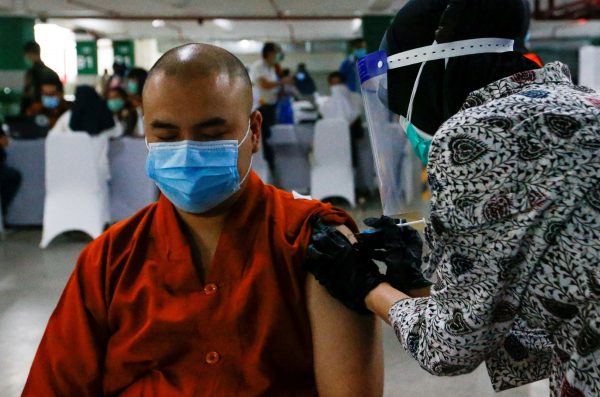These strong incentives to vaccinate do not mean there is no need for international cooperation. Past global vaccination efforts, such as that in response to smallpox, taught us that incentives and capacity are not the same thing. Asia’s developing countries may have strong incentives to vaccinate their populations, but this does not mean they have the capacity to do so. And providing them with that capacity faces incentive challenges of its own.
Asia faces enormous capacity challenges in distributing the vaccine. Infrastructure deficiencies are a major obstacle to herd immunity as geographically unequal logistics and health infrastructure make distribution difficult. Shallow government budgets, the inability to run large budget deficits and less effective monetary policy frameworks make it difficult to finance the purchase of vaccines and the necessary equipment and infrastructure to deliver them. Large undocumented populations and porous borders also make monitoring the rollout and secondary injections hugely challenging.
This is a problem. Painful historical experience shows that the eradication of a virus is a global public good since no country can be excluded from enjoying the benefits of a pandemic-free environment and one country’s enjoyment of that environment does not stop any other country from enjoying it too. But eradication is a special type of public good — called a weakest link public good — where eradication only succeeds if the country with the weakest healthcare system and control program eliminates the virus as well. If large pockets of the world remain unvaccinated, the virus will continue to exist and mutate, constantly re-emerging.
The problem with public goods is that they tend to be undersupplied. The burden will fall on the world’s rich countries, especially those in Asia. But these rich countries face several perverse incentives. One incentive is to ‘free-ride’ on the international assistance of others by providing no support to Asia’s developing countries themselves while hoping others fill the gap. Conversely, some countries may seek to provide the necessary international assistance themselves but do so with geopolitical strings attached. Another perverse incentive, which we already observe, is for rich countries to hoard the vaccine and maintain four or five times the stock they need ‘just in case’, pushing up prices and driving down supply of the vaccine globally.
Incentives are problematic at the individual level, too. The positive social benefit of one person getting the vaccine is that it protects others. Every two flu vaccinations, for example, help somebody else avoid a day off work, while every 4000 flu shots save a life. But the public-good nature of getting a vaccine means it risks being undersupplied. The incentive to line up and take time off work to get the vaccine for someone aged in their 20s — who faces a mere 0.01 per cent chance of dying if they catch COVID-19 — is very different from the incentive for someone elderly whose risk of mortality is 200 times greater.
To overcome these hurdles in Asia’s developing countries, international assistance and international cooperation are a must. In our lead article this week, Jeremy Youde examines two attempts to deliver this cooperation: COVAX — a joint partnership between the World Health Organization (WHO), the Coalition for Epidemic Preparedness Innovations (CEPI), and Gavi, the Vaccine Alliance (GAVI) — and so-called ‘vaccine diplomacy’, notably the efforts by the Indian and Chinese governments to supply the vaccine throughout developing Asia.
Youde shows that developing Asia is already lagging. ‘While many states in the Global North will achieve widespread vaccination by late 2021, middle- and low-income countries may not receive significant vaccine access until 2024’, Youde says. ‘Most Asian states have not yet been able to start vaccinating their populations, largely due to inadequate supplies and the high cost’.
Nearly every country in the world has signed on to the COVAX plan, giving a strong boost to its legitimacy and reinforcing the interdependence inherent in fighting global pandemics. Under this plan, Southeast Asian states should receive 695 million vaccine doses by the end of the year. But despite this optimism, Youde argues that COVAX faces three serious challenges that could limit its effectiveness: a lack of financial resources (the program is at least US$2 billion short of the funding needed), difficulty in overcoming logistical hurdles in distributing the vaccine (given the lack of domestic infrastructure) and the perverse incentive of rich countries to hoard the vaccine and pay more for it, pushing up prices and reducing supply for developing countries.
Vaccine diplomacy is moving quickly. India is giving free vaccines to Nepal, Bangladesh and Sri Lanka. China is making its vaccines freely available in Sri Lanka, Indonesia and other Southeast Asian countries as part of its Health Silk Road Initiative. ‘One main challenge’, Youde warns, ‘is how the recipient states navigate the geopolitical tensions that help to give rise to Indian and Chinese vaccine diplomacy efforts. Both countries have sought to use the vaccines to curry favour with regional partners, rebuild frayed diplomatic ties, and counteract diplomatic moves by the other. This could have far-reaching foreign policy effects for the receiving states, particularly if China and India overpromise and underdeliver’.
While COVAX and vaccine diplomacy signal progress, both are plagued by the usual challenge in supplying public goods: there is not enough. Multilateral forums, both globally (the G20) and regionally (ASEAN and APEC) need to put their support behind initiatives like COVAX. A firm commitment against the hoarding of vaccines and international agreement to properly fund COVAX are logical first steps. For the vaccine to be the circuit breaker many hope it will be, international cooperation is vital.
The EAF Editorial Board is located in the Crawford School of Public Policy, College of Asia and the Pacific, The Australian National University.
This article is part of an EAF special feature series on the COVID-19 crisis and its impact.

